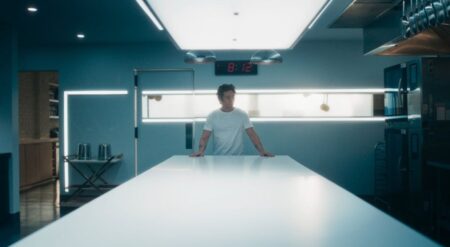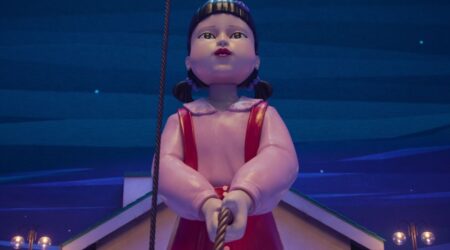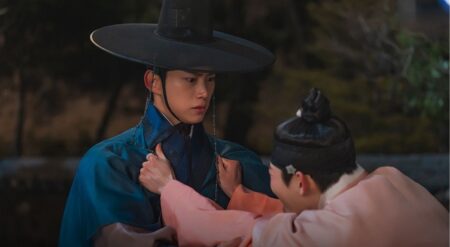Gyeongseong Creature closes out a strong year for Netflix Original series from South Korea. With a stellar cast that includes Park Seo-jun (also spelled Park Seo-joon) in the lead role, Wi Ha-joon, Han So-hee, Kim Hae-sook, Jo Han-chul, and Claudia Kim (aka Kim Soo-hyun), the series set in the spring of 1945 when Korea (then Joseon) was under Japanese occupation in the last days of World War II.
The people of the Gyeongseong area (Seoul today) have been kidnapped, forced to serve in the Imperial Japanese Army, or have just disappeared. At the center of it is the mysterious Ongseong Hospital. Controlled by the Japanese Army, an entrepreneur and sleuth, each tracking their own missing people, set their sights on the ominous building.
Directed by Jung Dong-Yoon and written by Kang Eun-Kyung, the series starts off with a hit, well, multiple hits, as we see Jang Tae-sang (Park Seo-jun) strapped to a chair and forced to find a missing person. The richest man in Gyeongseong and the influential master of the House of Golden Treasure, those titles mean nothing to the Japanese soldiers and leaders. However, this abuse is also against Tae-sang’s success, the beauty of the House of Golden Treasure, and the parties he attends.
Decked out in the finest fashion, there is a stark difference in how he’s treated by his community versus how the occupiers treat him. Set with a quest to find the mistress of a Japanese official, he starts his quest while the mysterious Yoon Chae-ok (Han So-hee) is on her own to find her mother. Directly confrontational and not teaming up on the best terms, Chae-ok and Tae-sang are two sides of the same coin, whether they want to admit it or not. Brought together through a mystery and held together by survival, this duo is perfection.
But Gyeongseong Creature Season 1 wouldn’t be a creature drama without, well, the titular strange creatures created in Ongseong Hospital by the Imperial Army in an attempt to create a weapon and new form of life with human greed at the center. Only they’re doing it at the cost of human life. With both of their missing persons said to be in the hospital, Chae-ok and Tae-sang form a team with others in the city to infiltrate the hospital. Their plan quickly turns from rescuing their charges and instead to destroying what the occupation has built. Released in two parts, this ten-episode series thrives on genre storytelling and powerful performances alike.
Park Seo-Jun showcases his acting depth in Gyeongseong Creature Season 1.

Park Seo-jun has already proven his acting depth this year with his role in Concrete Utopia, South Korea’s entry into the Academy Awards, but in Gyeongseong Creature Season 1, he does it again. His role as Tae-sang isn’t necessarily what we haven’t seen from him before. The cold detachment and arrogance are something that fans of his earlier work on What’s Wrong With Secretary Kim will recognize. However, the reason for that arrogance and how it masks his vulnerabilities is unique to see in actor Park’s role as Tae-sang, Master Jang. In every interaction, there is something more beneath the surface. There is reason for his defiance. That is a reason for his arrogance, and that is how you craft a dynamic character.
There is one moment in particular that stands out. He is called trash, and he embraces it. He says that he is trash because he had to crawl through it to get where he is. It’s an admission of his profession and his struggle, and it cuts his character’s arrogance down in a way that was unexpected. This is mirrored at the midpoint of the season when a Japanese man calls him trash after beating him.
Tears welling up in his eyes, he returns the blows and wins the fight in defiance. But, he still says that he is trash, but only because of what has been done to his country, hiding his sincerity behind bravado, his focus to survive no matter what is compelling, to say the least, especially when the group finds themselves stuck inside the hospital at the season’s halfway point.
Tae-sang is a character who stands out because of his charisma but excels in the series because of his vulnerabilities. The audience can see what even the wealthy deal with under the Japanese occupation, and it’s clear that his money doesn’t change anything in the eyes of the Japanese, who hold all the power. Tae-sang is filled with pride, but he’s not unaware of his situation nor the systemic oppression that is trying to make him buckle under its weight. He just chooses to be proud and arrogant in spite of it.
Historical trauma takes center stage in this Kdrama horror series.

For Wi Ha-joon, who had a phenomenal year with his performance in The Worst of Evil, his little time on-screen is used effectively to help build out Tae-sang’s relationships and give perspective to his role in Gyeongseong. While actor Wi’s Kwon Jun-taek seems underused at the start of the Gyeongseong Creature‘s Part 1, his character shines in a humbling and somber way by the time they enter the hospital. We see him cling to hope in tragedy and also watch it fall away.
For her part, actress Han is thrilling to watch on screen as Chae-ok. She is defiant, resilient, and capable of taking care of herself in a way that means she isn’t shackled by the conventions of the time. While some series reserve action moments for the heroes and not the heroines, Gyeongseong Creature Season 1 doesn’t.
Instead, Chae-ok is in the middle of the action and unphased by the danger—and equipped with some killer throwing knives as well. Having survived and fought in Manchuria, she was stoic in the face of those attacking her. Even when she is captured and threatened with assault, she refuses to give up her power.
“You may be able to violate me by force, but that doesn’t give any power at all,” Chae-ok says.
This is one of the many moments throughout the series that is both difficult to watch and directly confronting the violence enacted against Koreans under the Japanese occupation. It’s painful to see, but it keeps the series rooted in history. This is a historical drama, a creature feature, a sci-fi series, and horror all at once, and every piece of it exists to tackle a traumatic time in Korea’s history.
The showrunner also understands how to deftly allude to how Imperial soldiers tried to “break defiant women” without forcing the viewers to endure watching those violating acts on screen. The specter of it is enough; it’s never ignored, but you’re also never forced to bear witness to it.
Gyeongseong Creature is eccentric in parts but never out of step with history.

Still, none of the commentary on the past feels shoehorned; rather, all of it is reflective of a larger story. The experiments taking place in Ongseong Hospital are reminiscent of Unit 731, a covert biological and chemical warfare research and development in the Imperial Japanese Army. That unit infected prisoners with infectious diseases, experimented on pregnant women, performed amputations, and generally performed a wide range of brutal human rights violations in the name of science. It’s horrific, and Gyeongseong Creature taps into that in the same way films like Overlord have in the past.
There are many horrors inside the hospital, and they are painful to see, especially as we see the characters react. They’re treated like animals, experimented on, and kept in jars. The only thing that separates the one looking at the horror from the one being abused is time and place, nothing more and nothing less. The series captures the systemic abuses committed by the Japanese occupation, and it doesn’t sugarcoat or sidestep the dehumanization that happened to the citizens of Joseon at the time.
One of the stark details of the series is that it uses science fiction to hone in on the real-world horror that Koreans, more specifically Korean women, endured under Japan’s occupation. It is not lost on me as a viewer that the women being abducted and transformed into monsters or brutally tossed away may be fictional in this series, but that they reflect a historical reality that has still shaped the lives of many today.
Truthfully, though, it’s the steady hand with which historical trauma is approached that makes the series something astounding. Actor Park’s Master Jang has the most dynamic growth arc. Who he is at the start of the series is not who he is by the end of episode 10. From selfish to selfless, the series uses him to investigate complacency under oppression and how you wake up to it.
The series tackles a clear thing: How do you move to stop oppression?

But Master Jang is more than just called to rebellion. He articulates how those who do nothing are no better than those who oppress the people of Gyeongseong. His arc is about reclaiming what the Imperial Japanese army took, and that is not just their independence outside of occupation but their agency. Episode 9 of Gyeongsueng Creature is the high point of his growth.
When Lady Maeda attempts to threaten him into complacency, putting money for people as he always has done, he refutes her. He fights her. However, the series approaches that fight with nuance. When it’s revealed that everyone in his life has betrayed him or others, breaking under Imperial torture, Master Jang doesn’t blame them. Instead, the people who would be considered villains in other stories of revolution are seen as they really are. Broken people who are carrying trauma from the atrocities committed against them.
They broke, as would anyone. To understand that and to blame Imperial Japan and not the victims of their torture is a solid stance. Betraying others and making choices for survival would not have been necessary if they had not been broken systemically by their captors. Master Jang switches from complicit because of his inaction to defiant. Master Jang’s acceptance of his friends’ forced betrayal spits on Lady Maeda’s assumptions. Jang cares about survival because they have to survive “to tell the way what [the Japanese] did when it’s all over.”
Sci-fi and horror can be used to explore the past as much as the present, and in doing so, the genres can create space for viewers to process the historical trauma or, in other places, see catharsis once retribution is taken. While this is just Gyeongseong Creature Part 1, the catharsis will clearly need to come later, but for now, the foundation is laid. Even if our characters are pushed into desperation by the end of Part 1, Gyeongseong Creature Part 2 offers a thunderous catharsis.
Gyeongseong Creature offers more heartbreak than it does hope.

Even with the catharsis and retribution that Gyeongseong Creature offers, it also holds breathtaking heartbreak. Chae-ok and Tae-sang’s romance is a slow-burning undercurrent of the series. It isn’t the focus, but it pushes them both to value their lives and others more than they did initially. As they bond, their doomed fate becomes more and more apparent. Each step forward feels like they’re walking to a ledge. Their romance works because it’s not the focus but still holds emotional weight.
Gyeongseong Creature doesn’t just excel in its narrative and its characters but also in its costuming. The series recreates the fashion of the 1940s not just in silhouette but in fabric weight, texture, and color, creating a tactile experience. From Japanese Imperial uniforms to Jun-taek’s and Tae-sang’s suits or Chae-ok’s disguises, everything feels worn and thoughtful. The attention to detail for the clothes is also brought into the props, vehicles, and constructed sets of the street where Tae-sang’s House of Golden Treasure is located. The way that the buildings and neon signs frame the street is breathtaking. But the success of the practically built sets and effects work is also highlighted when the series’ CGI is rough around the edges.
If there are any critiques, it’s the stark line between practical and computer-generated buildings and surroundings. While it’s not always sticking out like a sore thumb, the times that it is are quite jarring. That said, when it matters, like with the city or in the creature design and execution, the series is visually electric.
The last element of critique stems from the choice of a closing song for a few of the episodes. It’s a modern pop tune that, while a good song on its own, often undercuts the emotional moments that immediately preceded it. Still, those are two small critiques that are also common for scripted dramas from all over; it makes it hard to dock a series that is filled to the brim with dynamic encounters between characters you root for and learn to care for, too.
A period piece, a mystery, a horror story, and a sci-fi tale, Gyeongseong Creature Season 1 is fantastic. It’s the perfect blend of history and horror, making it one of the best WWII stories to come out.
Gyeongseong Creature Season 1 and Season 2 are streaming now on Netflix.
Gyeongseong Creature Part 1
-
Rating - 9/109/10
TL;DR
A period piece, a mystery, a horror story, and a sci-fi tale, Gyeongseong Creature is a fantastic end to 2023, but with how this Part 1 ends, the wait for Part 2 will feel like a lifetime. It pushes the audience to look at the past through a genre lens and, in doing so, understand how powerfully a story can be told when rooted in history.







